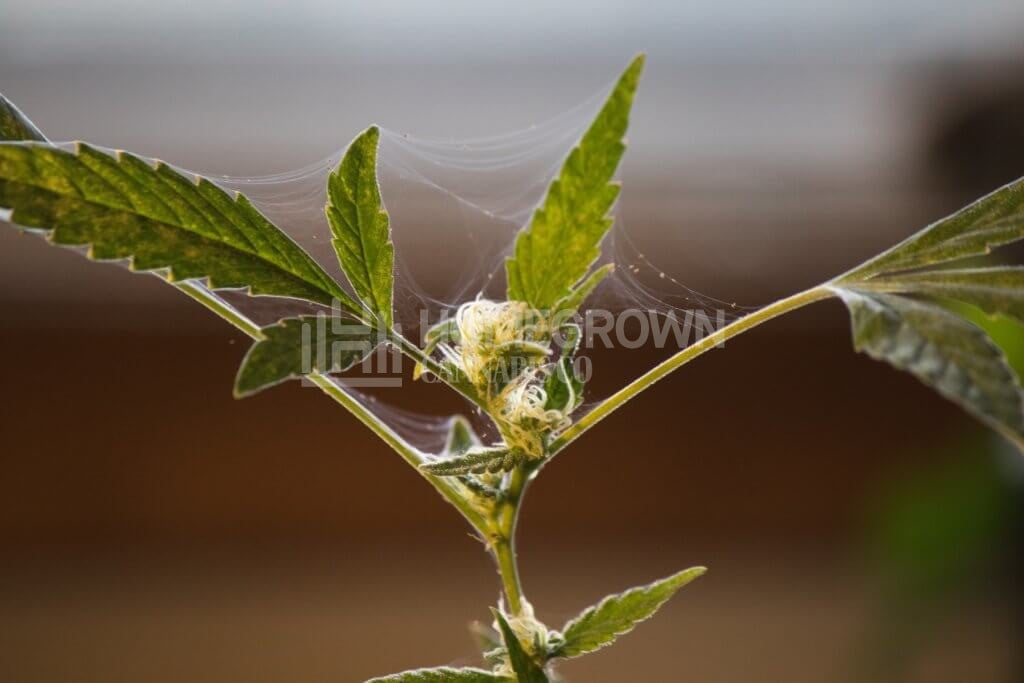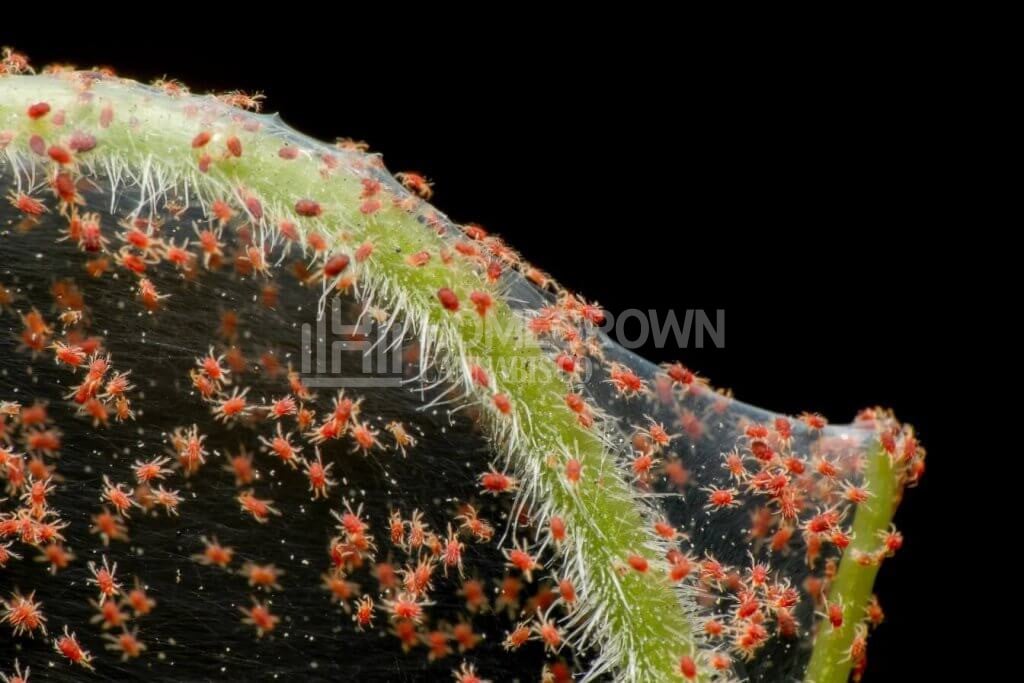How To Get Rid of Spider Mites on Weed Plants
You'll come across tons of nuisances along your cannabis cultivation journey — spider mites on weed are among the most infuriating. They're so tricky to handle that you can't help but admire their persistence (no, not really).
Worry not; we'll walk you through what they are, how to spot them, and assess the damage to your cannabis. We'll then wrap this up with ways to get rid of spider mites and prevent future infestations.
By the time you're done with this guide, they'll be sorry they picked the wrong grower to mess with. Now, let's turn you into a mean killing machine—for your marijuana's sake, of course.
What are spider mites?
Spider mites are pests—part of the mite family. They're related to ticks and spiders. These critters are so tiny that you barely notice they exist until there's a full-on spider mite infestation.
You'll likely get a visit when you increase temperature and lower humidity for your marijuana—they thrive in hot and dry environments. On arrival, they frolic undetected on the underside of the leaves. It only hits you that you have spider mites on weed when their fine webs start covering the herbs.
Spider mites are an issue both indoors and outdoors. Once they invade, they relentlessly suck the nutrients from cells in the leaves. They prefer soil but don't be fooled; they creep up on cannabis in any set-up.
What do spider mites look like?
What do spider mites look like, you ask? These little critters have an oval-shaped appearance separated into two parts; the mouth and the body. They're translucent and come in different shades of white, red, orange, brown, black, yellow, or green.
These pests start with three pairs of legs but get to four by maturity. Since they're the size of a dot (less than a millimeter big), you'll need a magnifying glass to see them distinctively. To the naked eye, spider mites on weed plants look like moving specks of dust.
The most common on cannabis is the two-spotted spider mite, known as 'the Borg'. This variant has two dark spots on the sides of its white, semi-transparent body. We don't know if the high keeps them coming back for more, but they sure give growers a hard time.
Where do spider mites come from?
Where do spider mites come from in the first place? Well, unfortunately, they can come from anywhere. What a nightmare!
All is not lost, though. We've compiled a list of ways they can find their way to your beloved crops:
- Being blown by air to your weed
- Mixing infested plants from other areas with yours
- Already the presence of spider mites in the soil you plan on adding to your garden or pots
- Pets and other animals transporting them to different locations
- You or others transferring them on clothes or shoes
- Using old, unsterilized equipment, they may be lurking on
We'll explain how to prevent spider mites from getting to your weed through these sources and more in a few.
Spider mites life cycle
Spider mites have a short five-stage life cycle. It starts with the eggs laid by adult females under the marijuana leaves. The eggs hatch into six-legged larvae, which feed all they need to, then find a cozy, dark area to molt into protonymphs.
The protonymphs, now eight-legged, follow that route and molt into deutonymphs which finally become the adult spider mites on cannabis. The whole process takes place in as little as a week if the conditions are right. A female adult lays up to 20 eggs a day, so you can imagine the stress on your herbs.
Their vicious life cycle makes a spider mite infestation one of the most brutal things a grower can experience. You happily eliminate the majority of the adults, unaware that a whole new generation is about to let loose.
Types of spider mites
You've probably come across different types of spider mites without realizing it. There are over a thousand species, including the southern red mite, tumid spider mite, and spruce spider mite. The globally notorious two-spotted spider mite (Tetranychus urticae) is known to terrorize marijuana frequently.
Typical ones are easier to deal with than specialized cannabis spider mites. These experts build resistance against the everyday spider mite treatment, so you'll need to go the extra mile. Either way, you don't have to know which type you're dealing with to eradicate them effectively.

How do you spot spider mites?
Detecting spider mites early saves both you and your cannabis from a long, frustrating experience. Sure, it's tough spotting the little pests, but it gets easier when you know exactly what to look for.
Here are a few warning signs you've got spider mite on weed issues:
- Lots of small bites called stippling that look like dots.
- The bitten parts become white, yellow, orange, or brown spots on leaves.
- If they've been around a while, you'll see their fine webs on different plant parts.
- Seeing them move around under the leaves. They resemble specks of dust or ground pepper.
- Infestations of spider mites on cannabis also show tiny, circular eggs on the bottom of the leaves.
Spider mites damage on weed
Spider mites damage weed when they puncture the leaf cells to suck all the nutrients. The weakened leaves begin to affect the whole plant. Growth slows down as the herbs struggle to share their nutrients with the mites.
The crop droops and buds have a hard time getting to their true size and maturity. Left untreated, the plant may die due to prolonged weakness.
Spider mite damage on leaves
Spider mite damage on leaves is quick and easy to spot since they're the point of attack. The bites result in dark holes in the leaves where sap and nutrients leak out. In turn, photosynthesis won't take place, and the spots begin to turn yellow.
The drying-out leaves eventually become weak and start curling. Without any spider mite treatment, they eventually start to fall off one after another.
Spider mites on buds at time of harvest
When you notice spider mites on buds at time of harvest, it may be too late to save them. Mites hinder the buds' ability to mature properly, making them remain small. As a result, it can affect the quality and potency as well.
If they're not damaged beyond repair, gently hose down the buds, or introduce mite predators. You can also spray a homemade spider mite killer that won't interfere with the taste.
How to get rid of spider mites infestation
In case you're still not convinced, here's why knowing how to get rid of spider mites on plants effectively matters:
- Their ability to rapidly multiply within a short time devastates weed.
- They rapture cells in the leaves and make it hard for plants to photosynthesize.
- Surviving mites build up resistance against the treatments.
- When you think they're gone, they return for vengeance.
- The webs make plants and buds unappealing.
- Their insatiable appetites can even kill whole herbs.
Now that you see the urgency, how do you get rid of spider mites?
How to get rid of spider mites on indoor plants
Learning how to get rid of spider mites on indoor plants is straightforward—you have more control over the environment.
To effectively eliminate them:
- Lower the temperature, increase humidity, and improve airing to slow their activity.
- Prune the infested leaves and dispose of them far from the grow room.
- Gently hose down the plants to wash away more mites and their webs.
- Use a homemade spider mite killer to get the job done. Safe, organic insecticides help as well. Avoid the buds at all costs.
- Switch between different treatments after every three days to prevent them from adapting to one.
- Stop for a week, then repeat the process a few more times.
- Introduce spider mite predators such as ladybugs, lacewings, minute pirate bugs, and others. Be careful to use treatments that won't harm them.
How to get rid of spiders on outdoor plants
How to get rid of spiders on outdoor plants is more or less the same with indoors. The wild may provide a challenge in this mission, though, but it's not impossible to complete. Lowering the temperature and increasing humidity creates the need for frequent watering.
Providing shade also reduces heat. You'll need to repeat the procedure more times and widen the range of the treatment. Remember, the spider mites have more room to escape or hide than indoors.
How to get rid of spider mites during flowering
Getting rid of spider mite during flowering is a more delicate procedure because compromising this stage could harm your harvest. Use the steps listed for indoor elimination with great care, paying close attention to the developing thick foliage.
Remember to increase air circulation and avoid using chemical spider mites on plants treatment unless there's no other option. Repeating the eradication process helps your plants get ready for a healthy spider mite-free harvest.
Homemade spider mite killer
The good news is, making a homemade spider mite killer saves you money, and you're sure it's safe. Store-bought products should always be a last resort.
Ideas include:
- Making a spray of alcohol and water in the ratio of 9:1
- A homemade pepper spray with the proper ingredients and measurements
- A tablespoon of bleach to a gallon of pH-balanced water that's 95° Fahrenheit
- Essential oils such as neem, cinnamon, and rosemary in water
- Horticultural vegetable oils like cottonseed mixed with water
- Homemade insecticidal soap (dish soap and water in the ratio 1:4)
- A garlic spray
- Diluted vinegar
- Vacuuming

How to prevent spider mites?
Knowing how to prevent spider mites from invading is even better than having to get rid of them. It protects your weed from damage and you from the hassle of it all. If you've already dealt with them, here's how to reduce the chances of going through it all again:
- Quarantine new plants—separating new additions from the regulars prevents you from potentially spreading spider mites on weed plants. Closely observe the newbies for any irregularities.
- Install air filtration systems—filtering air that comes into your grow room stops any blown spider mites in their tracks. Remember to clean the vents.
- Inspect your cannabis leaves and plants often—use a magnifier to catch any spider mites on weed before they reproduce further.
- Practice extreme cleanliness—change your clothes and shoes before going into your grow room, and ask others to do the same. Don't leave any dead leaves or extra materials lying around. Sterilize old equipment before use.
- Thoroughly treat new or reused soil before adding to your plants—spider mite treatment beforehand kills any that may be lurking around.
- Keep pets and animals away—prevent pets from coming into your grow room or animals from getting close to your weed outside.
- Don't remove the predatory insects—they'll continue to feed on any left behind, making them excellent for spider mite prevention.
- Maintain low temperatures and high humidity—this creates a hostile environment for spider mites. Be careful because extremes damage your weed.
FAQs about spider mites on weed
We understand dealing with spider mites is a tricky matter to handle. Here are a few common questions we've come across to assist further:
Will spider mites kill my weed plant?
They totally will if left untreated.
Spider mites destroy whole plants when given a chance. Their rapid reproduction, coupled with draining nutrients directly from leaves, spells doom for any unlucky herb. Familiarize yourself with how to kill spider mites to stop that from happening easily.
Can plants recover from spider mites?
Yes and no—it depends on the damage caused.
Spider mites slowly weaken the plants they feed on—the leaves, all yellow and frail, start falling off, and growth slows down. The more they attack, the more damage they inflict. Killing spider mites in the early stages of an infestation gives your plants enough time to heal.
What kills spider mites and their eggs?
The spider mite treatments listed should kill both the mites and their eggs.
Always ensure that you switch the killing method every three days to prevent any survivors from building resistance. Repeat the procedure twice or more before taking a week's break to improve effectiveness.

The terminator: spider mites edition
With this guide, you won't need luck on your mission to kill spider mites—understanding the enemy is the first step in subduing them. Now that you know what they are, how they look, and their strengths and weaknesses, eradicating them should be easier.
Remember; perform frequent check-ups, repeat natural treatments regularly, and apply the necessary spider mite prevention measures.
Many other little creatures want to have your precious marijuana all to themselves. Homegrown Cannabis Co. helps you understand their dangers and how to prevent them from wreaking havoc. We'll even assist to identify culprits and eliminate them, so go ahead and browse our cannabis pests page today!
About the author: Derek LaRose
Also known as Kronic from The Cannabis Kronicles, Derek LaRose is a young ambitious cultivator and a staple educator for indoor cultivation.
